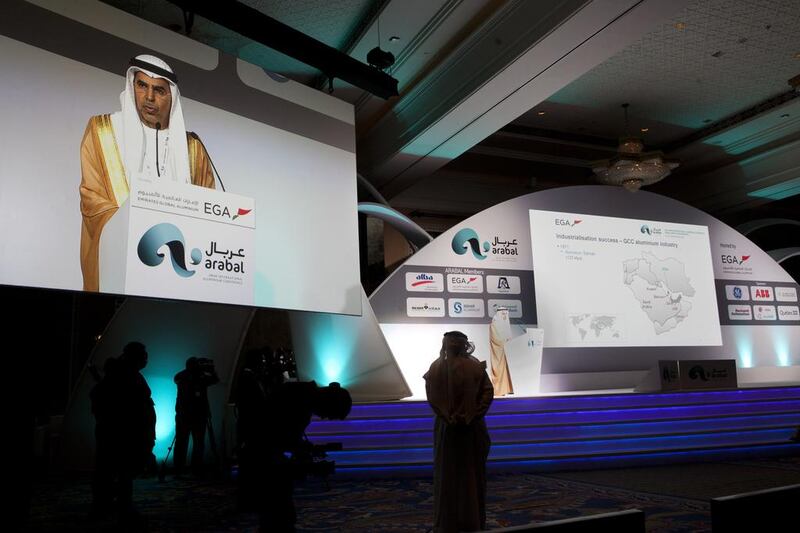Gulf aluminium producers are cutting costs as they grapple with oversupply and amid concerns about a potential rise in protectionism under a Donald Trump presidency, officials said today.
“The most important factor in our business is to protect our margin,” Abdulla Al Kalban, the chief executive of Emirates Global Aluminium, told the Arab International Aluminium Conference in Dubai today. “We keep hammering our costs every day.”
EGA, with an output of 2.4 million tonnes per year, is the Gulf’s largest aluminium producer and one of the world’s top 10 aluminium companies.
All five Gulf aluminium producers said they were cutting costs to deal with the glut exacerbated by low aluminium prices.
Benchmark aluminium prices on the London Metal Exchange have risen by 16.9 per cent so far this year but are still down by about half from an all-time high of US$3,380 per tonne, reached in July 2008.
But a Trump presidency is on the minds of Gulf executives.
The US is the biggest potential growth market for Gulf aluminium producers. But Mr Trump’s election promises to protect the domestic aluminium industry, impose tariffs on countries accused of dumping their commodities in the US and to scrap free trade agreements could thwart the Gulf companies’ plans.
“If all those promises are kept by him and if he is serious about it, definitely there will be a huge impact on aluminium,” said Khalid Laram, the chief executive of Qatalum, a joint venture between the state-run energy company Qatar Petroleum and Hydro Aluminium of Norway.
Gulf companies produce 5.27 million tonnes per year, about 10 per cent of the world’s total, said Mahmoud Daylami, the secretary general of the non-profit Gulf Aluminium Council.
Gulf producers are expected to reach 6 million tonnes by 2020, thanks mainly to the expansion of the smelter in Bahrain.
“The most promising market today if president Trump leaves things as it, I think, is the US,” said Mr Al Kalban. “The US is the biggest market globally and [it] can absorb as much as we, the five aluminium smelters here, supply into the US.”
Nearly 60 per cent of Gulf production is exported to markets such as the US, Asia, Japan and Europe, said Mr Daylami.
US smelters produced 1.59 million tonnes last year, 7 per cent less than in 2014 and 20 per cent lower than in 2011, according to the US Geological Survey. Such lower production has prompted Mr Trump to pledge to resurrect the industry.
“We are going to put American steel and aluminium back into the backbone of our country,” Mr Trump said in a speech in January.
Chinese production rose by nearly 12 per cent last year to 31.6 million tonnes, which is nearly double the 2010 output, according to the International Aluminium Institute. Global production of the metal rose by 7.3 per cent to 57.9 million tonnes last year from 2014.
China could retaliate if the US imposes tariffs on commodities such as aluminium and that could be a concern for the market, said Abdulaziz Al Harbi, the chief executive of Maaden Aluminium, a joint venture between the Saudi Arabian Mining Company (Ma’aden) and Alcoa of the US.
“There is a very high risk that the Chinese will come in to moderate any action if there is any increase either in tax or the position of the aluminium [industry] in the US,” said Mr Al Harbi.
Tim Murray, the chief executive of Aluminium Bahrain (Alba), was cautiously optimistic about a Trump presidency, saying that his position to boost infrastructure spending could be a boon for the construction industry and to aluminium.
Half of the new 540,000 tonnes capacity at Alba will be targeted for exports and the main export market is expected to be the US.
“The US is growing but there is no production, so consumption is growing very fast,” said Mr Murray. “It has to come from somewhere and I think it will continue to come from the Middle East.”
Most Gulf producers are seeking growth through supplying aluminium to the automotive industry, which is replacing steel, so the US remains the main market for this segment, the executives said.
Despite the lower prices, some Gulf producers have a long-term view on production. They are also boosting efficiency to maximise production, which will help them reach 6 million tonnes by 2020, according to Mr Daylami.
Qatalum, for example, is producing 8 to 10 per cent above its design capacity.
Some, such as Alba, are going for a $3 billion expansion that will boost capacity by 540,000 tonnes to 1.5 million tonnes per year by 2019.
dalsaadi@thenational.ae
Follow The National's Business section on Twitter





